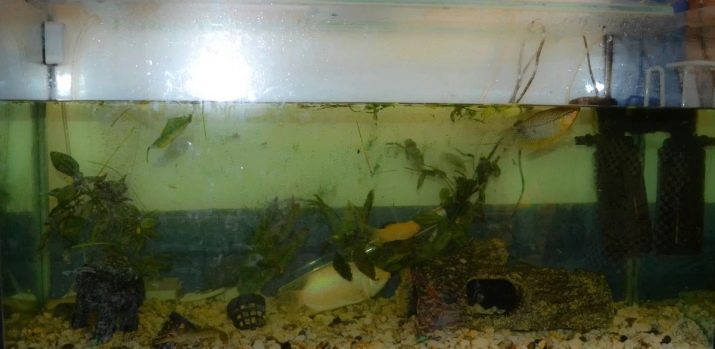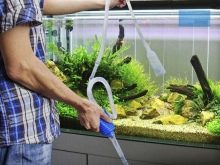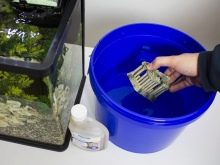A modern aquarium is not only a fish habitat, but also a thing that adorns the interior of a room. For this reason, absolutely all owners try to maintain its impeccable appearance. Nevertheless, even with careful care, the walls of an artificial pond can become covered with a strange green coating. You should know what kind of plaque it is, why it appears, and how to remove it.


What it is?
Sometimes the slightest change in the appearance of the aquarium causes the owner to panic, especially if the prerequisites for such changes were not observed. Green bloom occurs gradually, and it turns out thanks to a special type of algae, which is always in the aquarium. These algae are called protococcus and xenococcus. Most of the time they exist, they are harmless, and the green plaque obtained in the course of their life is removed relatively easily by hand or snails and ground catfish eat it.
However, if the ecosystem in the reservoir is disturbed, algae begin to multiply rapidly, and this leads to a variety of problems. Protococcus form green dust, which settles on the glass, and also covers the water surface. In advanced cases, nothing can be seen through the glass, and the wiped out coating appears again after a few days.
As for xenococcus, they parasitize on the leaves of plants, appearing in the form of dots. It is extremely difficult to remove overgrown spots; whole leaves have to be torn off. If you ignore the xenococcus, he will "lead" the new inhabitants.
The water reservoir will become a place of residence for more dangerous algae, for example, thread, which will cover with a fluff and fibers not only plants and glass, but also stones, aquarium decorations. This will serve as a starting point for the spread of fungus parasitizing on the bottom of stones, stems, moss.
Such organisms can already be considered dangerous, since they will affect the quality of water and the health of fish or other inhabitants of the aquarium.



Why appear?
The appearance of green plaque is a question that is still being studied today, so there are a lot of opinions. We will single out the most basic and most probable ones.
- Problems with fast-growing plants. There are several options: there are too few such plants, they are not there at all, or they slowed down growth. Because of this, the nutrients that the aquarium is saturated with cause algae to multiply.
- A large amount of phosphorus in combination with a low nitrogen content. This becomes the reason for the rapid multiplication of protococcus, and the aquarium literally overgrows with greenery.
- Incorrect tank placement. Experienced aquarists know that no aquarium can withstand constant sunlight, but beginners, on the contrary, mistakenly believe that fish need a lot of natural light. Direct sunlight leads to the fact that algae begin to appear actively in the aquarium.
- Imbalance in temperature. Depending on the type of fish contained in the tank, a certain temperature should be set in it. If fluctuations in one direction or another occur, this provokes the propagation of algae, as well as diseases and poor health of the fish.
- Poor care. This is a rare cleaning. Even with modern cleaning systems, the level of cleanliness always has to be controlled independently. Fish may not eat the food, it will fall to the bottom and rot. In addition, fish waste also goes down and creates an excellent habitat for algae.
- Increased salt concentration. If you rarely change the water, do not stand up for it, or have recently undergone a salt treatment course for fish, this may well be another reason that the aquarium suddenly turned green.
It is very important to note that algae rarely begin to multiply due to any one factor. Basically, this process provokes a combination of reasons.

How to fight?
To get rid of brilliant green, so spoiling the appearance of the aquarium, experts suggest using one of the following methods.
Biological
This is the simplest and most natural method of dealing with an ailment at home, you only need to show a little patience.
It is reliably known that algae actively propagate for only 21 days, after which new cells do not arise, and old cells begin to die. This means that the aquarium must be left alone for 3 weeks, after which the coating will lighten and it can be quickly cleaned.
This technique will be slightly different in low-tech and high-tech aquariums. If the aquarium is low-tech (without an additional carbon dioxide supply system), then you need:
- clean the tank well;
- make a water change (30%);
- Do not add fertilizers or replace water for 21 days.


If the aquarium is high-tech, they do not change the water, but fertilizers continue to be applied, since they are needed for plants. However, their number should be reduced by 25%. After 3 weeks, the tank will need to be cleaned. Do this as follows:
- all inhabitants are temporarily moved to another container;
- a hard sponge clean glass surfaces, completely removing plaque;
- poured water;
- thoroughly clean the scenery, loosen the soil, then treat it with a pump to remove all unnecessary particles;
- wash the aquarium outside;
- fill in new water, start the aquarium and set up all systems;
- when the parameters of water and temperature come back to normal, they start the fish.



Chemical
This method is suitable for those who need to return the appropriate appearance to the aquarium in a short time. One of the most popular means is streptomycin. To use it, you need to boil water, and then dilute the powder in a small amount (3 g of the drug per 1 liter of liquid). The resulting mixture is launched into the filter. Streptomycin acts quite quickly, and after a couple of days the walls of the container will completely clear. As a rule, fish do not notice such an intervention.


Besides, In any pet store, consultants will always offer you several options for chemicals designed specifically for the destruction of algae in aquariums. Judging by the reviews, the most acceptable solution would be drugs from Tetra, which can be either liquid or tabletted. Use them in accordance with the manufacturer's instructions about once a month.
At the same time, it must be remembered that during treatment it is impossible to additionally do activated carbon purification. And also it is necessary to remove the remains of algae in a timely manner so that they do not rot and do not spoil the ecosystem of the reservoir.


Mechanical
In part, this method is used during a biological procedure, but some take it into service as a single measure. As a complement, you can heed a few useful tips:
- do not use sponges and scrapers that were already in use for cleaning: they contain bacteria, both beneficial and harmful;
- be sure to protect your hands with gloves;
- if plaque is difficult to wash off, try prying it with a blade or remove it with an aquarium scraper;
- if the decorations cannot be washed, dilute a small amount of bleach in water, hold them in it for about 15 minutes, and then rinse with boiling water.



Preventive measures
Green bloom is an unpleasant problem, but it can be solved and, most importantly, not leading to the death of inhabitants. If you properly care for underwater pets, in a timely manner responding to any changes in the aquarium, then such an attack does not threaten at all. Having got rid of algae, many aquarists try to make this problem never appear again. And this is quite real, if you take note of some prevention rules.
- Organize the right lighting. Direct light provokes rapid cell division, and algae begin to multiply. Buy special fitolamps designed for aquariums. As for daylight hours, the best solution would be 8 hours. You can adjust the lights so that they work for several hours in the morning, and several in the evening.
- Keep track of temperature readings. They should be adjusted depending on the type of fish, but basically the average temperature does not exceed 24 °. At higher rates, the propagation of pathogenic microorganisms begins.
- Monitor the phosphate content. If their amount exceeds 0.8 mg / l, this is fraught with blooming water and the appearance of green plaque on the walls.
- Perform proper care. It includes cleaning and washing the soil, removing accumulated debris and undernourished food at the bottom, and cleaning filters and other systems.
- Calculate the amount of feed. This can be done by the experimental method, since each species of fish eats differently. If you see that a lot of food has been served and it has not been completely eaten, next time give smaller portions, so the aquarium will be much cleaner.
- Do not forget to change the water. Basically, fluid is replaced by 25% every week. At the same time, it must be defended in advance for several days in order for the chlorine to disappear. You can’t pour boiled water into the aquarium.
- Get some “orderlies” in the artificial pond, who will eat algae and harmful microorganisms. It is possible to advise somiks of ancistruses, corridors, labeos. Of snails, ampullarium and neretins will greatly help.And you can also populate the reservoir with shrimp: cherry or Amano.
- Plant some plants and take good care of them. The more plants you have in the aquarium, the less chance there will be of algae.


See a video below for tips on combating green algae in your aquarium.










